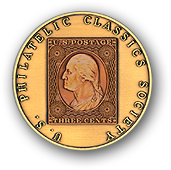Dr. Clarence Brazer, an architect by trade, turned to the study of essays and proofs as his architectural commissions dwindled during the great depression. His research evolved into a book (Essays for United States Adhesive Postage Stamps) on the subject and was published by the American Philatelic Society in 1941. By the time the book had been released Brazer had turned his avocation into his vocation. Until his death in 1956, Brazer was the leading proponent and dealer in U.S. essay and proof material. He was also the founding member of the now defunct Essay and Proof Society. The U.S. Philatelic Classics Society has taken up the Brazer mantle and features a section of essays and proofs in our quarterly journal, The Chronicle.
An essay is defined as a rejected design or a design that was not issued. In many cases an essay just reflects a stage in the design process.
A proof is defined as an impression of an approved design. Proofs come as either die or plate proofs. A die proof is an impression of a finished die. The die being the component used to lay down the plate. A plate proof is the product of a finished plate before it is placed into production. Plate proofs are pulled in sheet form on either India paper or card stock. Both die and plate proofs were used to “prove” the die or plate to make sure that neither contained any flaws.
Today both essays and proofs are widely collected. While many are quite rare and command large prices there is still a large range of material that is most affordable to the average collector. Below is the start to finish of the design process for the 1861 3¢ (Scott # 65).









Siegel Encyclopedia U.S. Proofs & Essays

